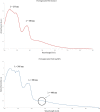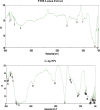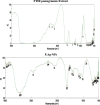Green synthesis of silver nanoparticles derived from lemon and pomegranate peel extracts to combat multidrug-resistant bacterial isolates
- PMID: 37815647
- PMCID: PMC10564695
- DOI: 10.1186/s43141-023-00547-0
Green synthesis of silver nanoparticles derived from lemon and pomegranate peel extracts to combat multidrug-resistant bacterial isolates
Abstract
Background: Multidrug-resistant (MDR) bacteria are acknowledged as one of the main factors contributing to chronic illnesses and fatalities globally. Numerous diseases, including bloodstream infections, pneumonia, urinary tract infections, and surgical site infections, can be brought on by MDR bacteria. Therefore, a crucial topic of continuing research is the development of a novel and different treatment for MDR microbial pathogens. This work is introduce an alternative method for elimination of MDR bacterial isolates which are causative agents of urinary tract infection among people in Egypt. In our study, we need a novel strategy to combat MDR bacteria by green-synthesized metal nanoparticles (MNPs). That is due to the ability of MNPs to penetrate the cell wall and the cell membrane of gram-positive and gram-negative bacteria.
Methods: Clinical isolates of MDR bacteria had their antibiotic susceptibility assessed before being molecularly identified using 16 s rRNA, sequencing, and phylogenetic analysis. Also, genetic profiles of isolated strains were performed using ISSR and SDS-PAGE. Finally, characterized plant-mediated silver nanoparticles derived from lemon and pomegranate peel extracts were evaluated against isolated multidrug-resistant bacterial stains.
Results: In our present trial, one-hundred urine samples were collected from 71 females and 29 males complaining of UTI (urinary tract infection) symptoms. One-hundred microbial isolates were isolated, including 88-g negative and only 8-g positive bacteria in addition to four yeast isolates (Candida species). A total of 72% of the isolated bacteria showed MDR activity. The most prevalent MDR bacterial isolates (Escherichia coli, Pseudomonas aeruginosa, Acinetobacter baumannii, Enterococcus faecalis, and Klebsiella pneumoniae) were identified through 16S rDNA PCR sequencing as with accession numbers OP741103, OP741104, OP741105, OP741106, and OP741107, respectively. Lemon and pomegranate-mediated silver nanoparticles [Ag-NPs] were characterized by UV spectroscopy, FTIR, XRD, and TEM with average size 32 and 28 nm, respectively. Lemon and pomegranate-mediated silver nanoparticles [Ag-NPs] showed an inhibitory effect on the selected five MDR isolates at MIC 50 and 30 µg/mL, respectively. These common bacterial isolates were also genetically examined using ISSR PCR, and their total protein level was evaluated using SDS-PAGE, showing the presence of distinct genetic and protein bands for each bacterial species and emphasizing their general and protein composition as a crucial and essential tool in understanding and overcoming MDR behavior in UTI patients.
Conclusions: Lemon and pomegranate-mediated silver nanoparticles [Ag-NPs] were found to have an inhibitory effect on MDR isolates. Therefore, the study suggests that [Ag-NPs] could be a potential treatment for MDR UTI infections caused by the identified bacterial species.
Keywords: ISSR; Lemon peel extract; Multidrug-resistant bacteria; Pomegranate peel extract; SDS-PAGE; Silver nanoparticles.
© 2023. Academy of Scientific Research and Technology.
Conflict of interest statement
The authors declare that they have no competing interests.
Figures













References
-
- Murugan M, Rani KB, Wins JA, Ramachandran G, Guo F, Mothana RA. Green synthesized ZnO NPs as effective bacterial inhibitor against isolated MDRs and biofilm producing bacteria isolated from urinary tract infections. J King Saud Univ-Sci. 2022;34:101737. doi: 10.1016/j.jksus.2021.101737. - DOI
-
- Ullah A, Shah S, Almugadam B, Sadiqui S. Prevalence of symptomatic urinary tract infections and antimicrobial susceptibility patterns of isolated uropathogens in Kohat region of Pakistan. MOJ Biol Med. 2018;3:85–89. doi: 10.15406/mojbm.2018.03.00082. - DOI
LinkOut - more resources
Full Text Sources
